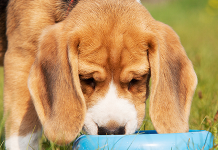When is an Afador Dog Full Grown?
An Afador dog, a mix between an Afghan Hound and a Labrador Retriever, typically reaches full physical maturity at around 12 to 18 months of age. By this time, they have usually reached their full size and weight. However, it’s important to note that some individual dogs may continue to fill out and develop their muscle mass even after they have reached their full height.

Keep in mind that each dog is unique, and genetics and environmental factors can influence the rate of growth and development. Proper nutrition, regular exercise, and regular veterinary care play essential roles in ensuring your Afador dog reaches its full potential. Always consult with your veterinarian for personalized advice and guidance on your specific dog’s growth and development.
What Impacts the Size of an Afador Dog?
The size of an Afador dog, like any mixed breed, can be influenced by a combination of genetic and environmental factors. Here are some of the key factors that impact the size of an Afador:
Genetics: The genetic makeup of the Afador’s parent breeds, the Afghan Hound and the Labrador Retriever, will play a significant role in determining the size of the offspring. Genes from both parents can be passed down, leading to variations in size.
Parent Size: The size of the individual parent dogs can be a good indicator of how big the Afador puppy will grow. If both parents are larger, the offspring is likely to be larger as well. Similarly, if both parents are smaller, the puppy is likely to be on the smaller side.
Nutrition: Proper nutrition during the puppy’s developmental stages is crucial for healthy growth. A balanced and appropriate diet with all the necessary nutrients will support proper growth and development.
Health: Any health issues or medical conditions that affect the puppy’s growth can impact their overall size.
Exercise: Adequate exercise during the puppy’s growth phase is essential for building strong muscles and bones. Regular physical activity helps the puppy reach its full potential in terms of size and overall fitness.
Neutering/Spaying: There is some evidence to suggest that early neutering or spaying can affect the growth and size of certain dog breeds. However, the impact on mixed breeds like the Afador may not be as well-studied.
Lifestyle and Environment: The environment in which the puppy grows up can also play a role in its size. A safe and stress-free environment allows for healthy growth, while a stressful or unhealthy environment can have negative effects.
It’s important to remember that while these factors can influence the size of an Afador dog, there can still be variations among individual dogs, even within the same litter. Always consult with a veterinarian to ensure your puppy is growing healthily and to get personalized advice on their specific needs.
How Big Do Afador Dogs Get?
The size of Afador dogs can vary depending on their genetic inheritance from the Afghan Hound and Labrador Retriever parent breeds. On average, Afador dogs are considered to be medium to large-sized dogs. Here are some general guidelines for the size range of Afador dogs:
- Height: Afador dogs typically stand between 20 to 29 inches (50 to 74 cm) tall at the shoulder.
- Weight: The weight of Afador dogs usually ranges from 50 to 100 pounds (23 to 45 kg).
It’s important to note that there can be considerable variation in size within the same litter of Afador puppies due to the influence of genetics from both parent breeds. Some Afador dogs may lean more towards the Afghan Hound’s lean and elegant physique, while others may have a stockier and more robust appearance like the Labrador Retriever.
Additionally, the size and weight of an Afador dog can also be influenced by factors such as nutrition, exercise, and overall health. Providing proper care and attention to their diet and exercise routine will help ensure they reach their full potential size in a healthy and balanced manner.
When Do Afador Dogs Stop Growing?
Afador dogs generally reach their full physical maturity and stop growing between 12 to 18 months of age. By this time, they have usually reached their adult height and weight. However, as mentioned earlier, some individual dogs may continue to fill out and develop muscle mass even after they have reached their full height.
It’s important to note that while the majority of their growth occurs during the first year, some larger dog breeds like the Afador may continue to fill out and develop their full adult body until they are around 2 years old or even slightly older.
The growth rate and timeline can vary among individual dogs, and genetics, nutrition, and overall health can influence how quickly an Afador reaches its full size. Regular veterinary check-ups and proper care during the puppy’s growth phase are essential to ensure they grow up healthy and strong. Always consult with your veterinarian if you have any concerns about your Afador’s growth or development.
When Do Afador Dogs Calm Down?
The age at which Afador dogs calm down can vary from one dog to another. As with many other breeds, individual temperament and personality play a significant role in determining when a dog becomes calmer. However, there are some general trends in their behavior:
Adolescence: Afador dogs, like many other breeds, go through their adolescent phase, which typically occurs between 6 months to 2 years of age. During this time, they may exhibit increased energy, curiosity, and a tendency to test boundaries. This period can be challenging for owners as the dog’s energy levels may seem higher and their behavior less predictable.
Maturity: As Afador dogs reach full physical and mental maturity around 2 years old, many tend to become more settled and calmer. They have expended much of their puppy energy and start to develop a more stable temperament. Their training and socialization during their formative months greatly influence their behavior as adults.
Lifestyle and Environment: The dog’s environment and lifestyle also play a role in their behavior. Regular exercise, mental stimulation, and social interactions can contribute to a calmer demeanor. Conversely, if a dog lacks adequate exercise or has pent-up energy, they may continue to exhibit more hyperactive behavior.
Training: Training plays a significant role in shaping a dog’s behavior. Consistent and positive reinforcement training helps instill good manners and self-control, contributing to a calmer and more well-behaved dog.
It’s essential to remember that every dog is an individual, and some Afador dogs may remain more energetic or playful throughout their lives. Early and ongoing training, regular exercise, mental stimulation, and a loving environment all contribute to a well-balanced and well-behaved dog. If you’re experiencing difficulties with your dog’s behavior, consulting a professional dog trainer or behaviorist can be beneficial in addressing specific issues and finding appropriate solutions.
Do Males and Females Grow the Same Size?
In general, male and female Afador dogs, like many other dog breeds, can vary slightly in size, but the differences are usually not significant. Both male and female Afadors typically fall within the same height and weight range.
However, it’s important to note that there can be individual variations, and some male Afador dogs may be slightly larger and heavier than their female counterparts, while others may be the same size or even smaller. The influence of genetics, the size of the parent breeds (Afghan Hound and Labrador Retriever), and other factors can all play a role in determining the size of individual male and female Afadors.
It’s important to focus on the overall health and well-being of the dog rather than worrying too much about slight differences in size between males and females. Providing proper nutrition, regular exercise, and regular veterinary care will help ensure that your Afador dog grows up to be healthy and happy, regardless of its gender.
How To Measure the size of an Afador Dog?
To measure the size of an Afador dog, you will need a measuring tape or a ruler. Here’s a step-by-step guide to measure your Afador’s height and length:
Measuring Height (Shoulder Height):
- Stand your Afador on a flat, level surface. Make sure they are standing up straight and not slouching or crouching.
- Position the measuring tape or ruler at the base of one of their front paws.
- Gently bring the measuring tape or ruler up to the top of their shoulder blades (withers), which is the highest point of their shoulders.
- Read the measurement where the top of the shoulder blades meets the measuring tape or ruler. This measurement represents the dog’s height at the shoulder.
Measuring Length (Body Length):
- Have your Afador stand or lie down in a stretched-out position on a flat surface.
- Position the measuring tape or ruler at the base of their tail.
- Carefully stretch the measuring tape or ruler along their spine, following the contour of
- their body, all the way to the tip of their nose.
Read the measurement where the tip of their nose meets the measuring tape or ruler. - This measurement represents the dog’s length from the base of the tail to the tip of the nose.
It’s essential to keep your dog relaxed and calm during the measuring process to get accurate measurements. Repeat the process a few times to ensure accuracy, as some dogs may fidget or move.
Measuring your Afador’s size can be a useful way to track their growth and development over time, especially during their puppy stages. It’s also beneficial for choosing the right-sized equipment, such as collars, harnesses, and crates, to ensure their comfort and safety.
Afador Dog Life Expectancy
The life expectancy of an Afador dog can vary based on various factors, including genetics, overall health, diet, exercise, and living conditions. As a mixed breed, the Afador may benefit from hybrid vigor, which refers to the potential for mixed-breed dogs to be healthier and have a longer lifespan compared to purebred dogs.
On average, an Afador dog’s life expectancy is around 10 to 15 years. Some individuals may live longer, while others may have a shorter lifespan depending on their specific circumstances and genetics.
To ensure your Afador has the best chance of living a long and healthy life, provide them with proper nutrition, regular exercise, routine veterinary check-ups, and a safe and loving environment. Early detection and treatment of any health issues can also contribute to their overall well-being and longevity. Remember to consult with a veterinarian for personalized advice on how to care for your specific Afador dog’s needs.
Fun Facts About Afador Dogs
Mixed Heritage: The Afador is a crossbreed between the Afghan Hound, a graceful and elegant sight hound, and the Labrador Retriever, a friendly and versatile retriever. This mix results in a unique and intriguing combination of traits.
Great Family Pets: Afador dogs are known for their friendly and affectionate nature, making them excellent family pets. They are often good with children and get along well with other pets when properly socialized.
Energetic and Active: Afadors are energetic dogs that require regular exercise and mental stimulation to stay happy and healthy. They enjoy activities like playing fetch, running, and going for long walks.
Intelligent and Trainable: Both parent breeds of the Afador are highly intelligent, and this trait is usually inherited by their offspring. They tend to be trainable and can learn various commands and tricks.
Grooming Needs: Afadors may have different coat types, depending on which parent’s genes dominate. Some have a shorter, easy-to-maintain coat, while others may have longer, more flowing hair. Regular grooming is necessary to keep their coats healthy and free from matting.
Loyal Companions: Afadors often form strong bonds with their owners and can be loyal and devoted companions.
Good Watchdogs: With their keen senses and alertness, Afador dogs can be effective watchdogs. They will bark to alert their owners of any potential intruders or unusual activities.
Athletic and Agile: The combination of traits from both parent breeds makes Afador dogs agile and athletic. They may have a natural inclination for running and jumping.
Rescue Work Potential: Given the Labrador Retriever’s history as a waterfowl retriever and the Afghan Hound’s hunting abilities, Afadors may have potential as search and rescue dogs or in scent detection work.
Individual Variation: As with all mixed breeds, each Afador dog is unique, and their appearance, personality, and temperament can vary from one individual to another.
Always consider adopting from shelters or rescue organizations if you’re interested in getting an Afador or any other dog breed. Adopting a mixed breed can be a rewarding experience, and you may find a loving and loyal companion.
Afador Dog Full Grown: Frequently Asked Questions
Q: When is an Afador dog considered full grown?
A: Afador dogs typically reach their full physical maturity between 12 to 18 months of age. By this time, they have usually reached their full height and weight, though some may continue to fill out and develop muscle mass beyond this age.
Q: How big do Afador dogs get?
A: Afador dogs are medium to large-sized dogs, with a height ranging from 20 to 29 inches (50 to 74 cm) at the shoulder and a weight between 50 to 100 pounds (23 to 45 kg).
Q: Do male and female Afador dogs grow the same size?
A: Generally, male and female Afador dogs are similar in size, but there can be slight individual variations. Some male Afadors may be slightly larger and heavier, while others may be the same size or smaller than females.
Q: When do Afador dogs stop growing?
A: Afador dogs usually reach their full physical maturity and stop growing between 12 to 18 months of age. However, some larger dog breeds like the Afador may continue to fill out and develop their full adult body until they are around 2 years old or slightly older.
Q: How long do Afador dogs live?
A: The life expectancy of an Afador dog is typically between 10 to 15 years, but individual dogs may live longer or shorter lives depending on their health and care.
Q: What impacts the size of an Afador dog?
A: The size of an Afador dog can be influenced by genetics from the Afghan Hound and Labrador Retriever parent breeds, nutrition, health, exercise, and environmental factors.
Q: Are Afador dogs good family pets?
A: Yes, Afador dogs are often good family pets. They are known for their friendly and affectionate nature, and they tend to get along well with children and other pets when properly socialized.
Q: Are Afador dogs trainable?
A: Yes, Afador dogs are usually trainable and can learn various commands and tricks. They inherit intelligence from both parent breeds, which makes them quick learners.
Q: What is the grooming needs of an Afador dog?
A: Afador dogs may have different coat types, depending on which parent’s genes dominate. Some have a shorter, easy-to-maintain coat, while others may have longer, more flowing hair. Regular grooming is necessary to keep their coats healthy and free from matting.
Q: Do Afador dogs make good watchdogs?
A: Yes, Afador dogs can make good watchdogs due to their alertness and keen senses. They will bark to alert their owners of any potential intruders or unusual activities.
Conclusion
In conclusion, the Afador dog is a unique and fascinating mix between the Afghan Hound and Labrador Retriever breeds. They are medium to large-sized dogs with a friendly and affectionate nature, making them excellent family pets. Afador dogs are known for their intelligence, trainability, and athleticism, making them ideal companions for active families.
As with any mixed breed, individual Afador dogs may vary in size, appearance, and temperament due to the influence of genetics from both parent breeds. They typically reach full physical maturity between 12 to 18 months of age, and their life expectancy is around 10 to 15 years.
Proper care, including a balanced diet, regular exercise, grooming, and routine veterinary check-ups, is essential to ensure the well-being and longevity of Afador dogs. Training and socialization during their formative months play a crucial role in shaping their behavior as adults.
Remember, adopting an Afador or any mixed breed from shelters or rescue organizations can be a rewarding experience and provides a loving home to a deserving dog.
Always seek professional advice from veterinarians or trainers for personalized care and training tips for your specific Afador dog. With proper care and love, an Afador can be a loyal and cherished companion for many years to come.






